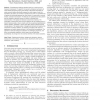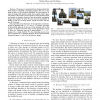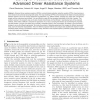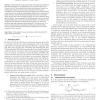127
Voted
PAMI
2010
14 years 11 months ago
2010
—Facial expression is a natural and powerful means of human communication. Recognizing spontaneous facial actions, however, is very challenging due to subtle facial deformation, ...
110
Voted
PAMI
2010
14 years 11 months ago
2010
—A spatiotemporal saliency algorithm based on a center-surround framework is proposed. The algorithm is inspired by biological mechanisms of motion-based perceptual grouping and ...
117
click to vote
PAMI
2010
14 years 11 months ago
2010
While feature point recognition is a key component of modern approaches to object detection, existing approaches require computationally expensive patch preprocessing to handle pe...
107
click to vote
PAMI
2010
14 years 11 months ago
2010
— We propose a randomized data mining method that finds clusters of spatially overlapping images. The core of the method relies on the min-Hash algorithm for fast detection of p...
99
Voted
PAMI
2010
14 years 11 months ago
2010
—Advanced driver assistance systems (ADASs), and particularly pedestrian protection systems (PPSs), have become an active research area aimed at improving traffic safety. The maj...
89
Voted
PAMI
2010
14 years 11 months ago
2010
Computer-vision attention processes allocate computational resources to different parts of visual input and can lead to faster object recognition and image analysis. This paper p...
126
Voted
PAMI
2010
14 years 11 months ago
2010
— This paper describes the large-scale experimental results from the Face Recognition Vendor Test (FRVT) 2006 and the Iris Challenge Evaluation (ICE) 2006. The FRVT 2006 looks at...
PAMI
2010
14 years 11 months ago
2010
—Representing 2D and 3D data sets with implicit polynomials (IPs) has been attractive because of its applicability to various computer vision issues. Therefore, many IP fitting m...
125
click to vote
PAMI
2010
14 years 11 months ago
2010
—We present a generative model and inference algorithm for 3D nonrigid object tracking. The model, which we call G-flow, enables the joint inference of 3D position, orientation, ...
137
click to vote
PAMI
2010
14 years 11 months ago
2010
— We present a self-calibrating photogeometric method using only off-the-shelf hardware that enables quickly and robustly obtaining multi-million point-sampled and colored models...







